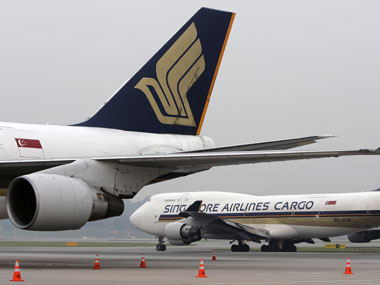Ratan Tata’s long standing but unrealised dreams may finally be getting wings.
Nearly 20 years after their first attempt to operate an airline in India was thwarted due to bureaucratic meddling, Tata Sons and Singapore Airlines on Thursday announced plans to set up a full-service domestic carrier with an initial investment of $100 million.
Tata Sons will pump in $51 million for a 51 percent stake and Singapore Airlines will invest $49 million for the remaining 49 percent.
The announcement, however, has come as a surprise as the Tata Group had earlier this year signed an agreement with Malaysian budget carrier AirAsia to launch an Indian low-cost carrier.
According to various media reports,Singapore Airlines had first approached Tatas in mid-2012 with the proposal to start a full-service carrier and it was much later in September 2012 the government changed rules permitting foreign airlines to pick up to 49 percent stake in domestic carriers.
“Talks between the two sides continued even as the Tatas initiated discussions with AirAsia for the low-cost airline,” an Economic Times report pointed out.
[caption id=“attachment_1121959” align=“alignleft” width=“380”]
 Reuters[/caption]
Reuters[/caption]
Tatas, which controlled India’s national carrier Air India before it was nationalized 60 years ago, also holds a small stake in Spicejetand operates an air-catering business in partnership with SIA.
Impact Shorts
More ShortsHere are some key facts about the dea:
1. **FDI approval:**Tata Sons and Singapore Airlines have applied to the Foreign Investment Promotion Board (FIPB) for approval of the new airline. After securing the FIPB and other regulatory approvals, the new airline will be based in New Delhi and help further stimulate demand for air travel.
2. Ratan Tata’s unrealised dream may finally get wings: The Tata Group had attempted to start an airline in collaboration with Singapore Airlines was back in the early 1990s, but the proposal was in cold storage for years due to various reasons.In 2001, the Tata group made another attempt to pick up a 40 percent stake in Air India, with Singapore Airlines as a partner, through a disinvestment process. But opposition to the deal forced the foreign carrier to back out. This is effectively the Tata Group’s third attempt to take to the Indian skies in a span of two decades.
3. Board structure:The three-member board of the Tata-Singapore Airlines venture will have two Tata nominees - Tata Industries Director Prasad Menon as chairman, and member of Tata Sons’ executive council, Mukund Rajan. Mak Swee Wah, SIA’s executive vice-president (commercial) will represent the foreign carrier.
4. **Ajit Singh aware of new JV proposal:**The Civil Aviation Ministry said that it was up to the Securities and Exchange Board of India and the Corporate Affairs Ministry to clear the Tata Group’s new joint venture with Singapore Airlines.Addressing reporters, Civil Aviation Minister Ajit Singh said: “Aviation rules do not bar Tatas from having two ventures. It is for Sebi and Ministry of Corporate Affairs to clear such ventures (in case of conflict of interest).”
5. AirAsia vs Singapore Airlines: The Tatas have maintained that there is no conflict of interest withTata Sons’ three-way joint venture with AirAsia and Telstra Tradeplace for a low-cost airline as the two airlines do not compete in the same space. “AirAsia has been fully aware of this joint venture and has no objection to the partnership,” a company spokesperson has been quoted as saying by CNBC-TV18.
In fact a B usiness Standard report goes on to to say that rather than competing with each other, the two carriers will compliment each other.“For instance, AirAsia is launching its Indian operations with an Airbus A-320, while SIA has a variety of Airbus aircraft. A common fleet, with common spares and maintenance support, could be one key area of synergy between the two,” the report said.
The Indian JV airline could also benefit from SIA’s expertise in running a cargo and engineering services company. Apart from revenue benefits, it could also help save cost. Experts also told the Economic Times that with the cash-rich Tata Sons by its side, the new full-service airline can weather losses and competition from existing players such as Jet Airways and SpiceJet.
Singapore Airlines along with its subsidiary Silk Air already operates about 100 flights a week into 11 Indian cities and the alliance with Tata will help Southeast Asia’s biggest carrier expand its presence here.
6.There could still be ownership problems: The announcement could play out negatively on AirAsia’s regulatory approval as Tata have a 30 percent stake in the JV with the chairman also from Tata Sons. More clarity is required from Tatas on their proposed airline investments, said Kapil Kaul, CEO, South Asia, aviation consultancy firm Centre for Asia Pacific Aviation.
He added thatTata may have to clarify its ownership trends in both the airlines. They are just a financial investor in AirAsia, whereas they lead in the JV with Singapore Airlines, which might have to be clarified, he said in an interview with CNBC-TV18.
Amber Dubey, Partner and Head - Aerospace and Defense, KPMG too agrees that the biggest challenge for the JV will be in the boardroom with the two deals.
“Questions are being asked about the Tatas entering into two separate JVs. As long as there is no violation of FDI norms and national security, these deals are best left to the companies involved and market forces”, Dubey added.
8.Analysts believe that this full-service venture will focus more on west-bound travel while the AirAsia JV will stick to ASEAN routes: “This will open up competition in the westbound routes from India. Nearly 70 percent of global traffic from India is westbound - to Middles East, EU and Americas. With this JV, SIA gets a play in the growing international travel from India. SIA can also operate direct flights to Far East and Australia from India or route them through Singapore”, Dubey added.
9. **Details only later:**The details of the proposed airline, including its brand and management team, will be announced in due course
)